投资组合管理[1]
- 格式:ppt
- 大小:587.00 KB
- 文档页数:51
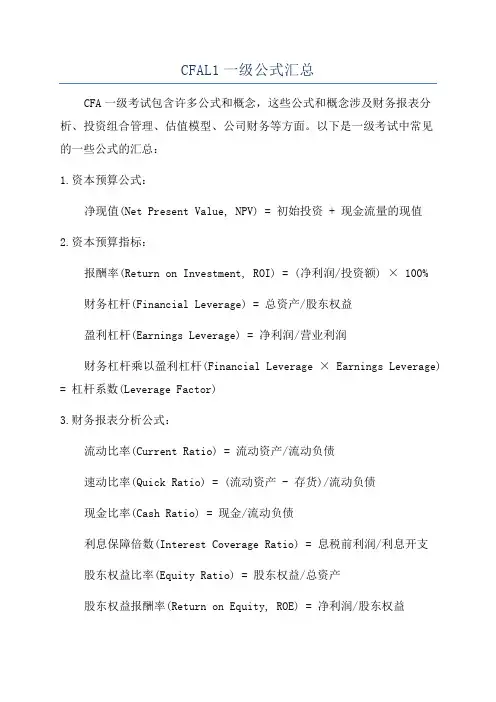
CFAL1一级公式汇总CFA一级考试包含许多公式和概念,这些公式和概念涉及财务报表分析、投资组合管理、估值模型、公司财务等方面。
以下是一级考试中常见的一些公式的汇总:1.资本预算公式:净现值(Net Present Value, NPV) = 初始投资 + 现金流量的现值2.资本预算指标:报酬率(Return on Investment, ROI) = (净利润/投资额) × 100%财务杠杆(Financial Leverage) = 总资产/股东权益盈利杠杆(Earnings Leverage) = 净利润/营业利润财务杠杆乘以盈利杠杆(Financial Leverage × Earnings Leverage) = 杠杆系数(Leverage Factor)3.财务报表分析公式:流动比率(Current Ratio) = 流动资产/流动负债速动比率(Quick Ratio) = (流动资产 - 存货)/流动负债现金比率(Cash Ratio) = 现金/流动负债利息保障倍数(Interest Coverage Ratio) = 息税前利润/利息开支股东权益比率(Equity Ratio) = 股东权益/总资产股东权益报酬率(Return on Equity, ROE) = 净利润/股东权益4.会计公式:利润总额=营业收入-营业成本-营业税金-利润分享给优先股东-利润分享给普通股东净利润=利润总额-所得税总资产=股东权益+负债股东权益=资产-负债5.宏观经济指标公式:国内生产总值(Gross Domestic Product, GDP) = 消费者支出 + 投资 + 净出口通货膨胀率(Inflation Rate) = (物价指数现值 - 物价指数上期值)/物价指数上期值×100%6.估值模型公式:股票估值=(股票股利/折现率)+终值折现债券估值=公允价值-未来现金流量的现值现金流估值(Cash Flow Valuation) = 现金流量/折现率7.风险管理公式:标准差(Standard Deviation) = [(X1 - μ)^2 + (X2 - μ)^2 + (X3 - μ)^2 + ... + (Xn - μ)^2/(n-1)]^(1/2)协方差(Covariance) = [(X1 - μx)(Y1 - μy) + (X2 - μx)(Y2 - μy) + (X3 - μx)(Y3 - μy) + ... + (Xn - μx)(Yn - μy)]/(n-1)以上是CFA一级考试中一些常见的公式。
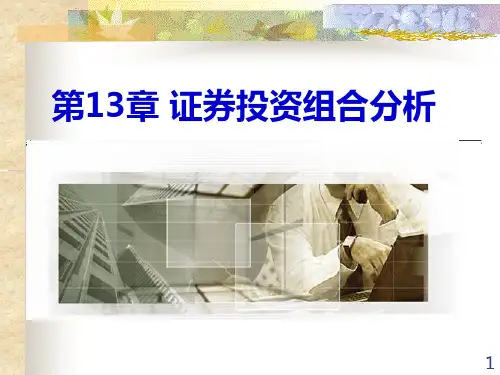
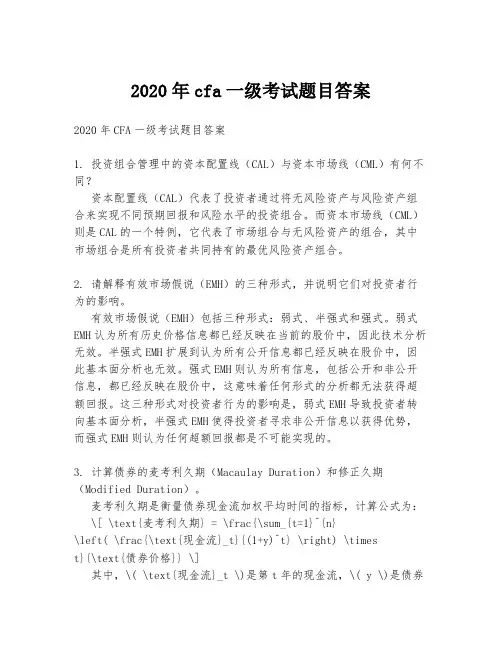
2020年cfa一级考试题目答案2020年CFA一级考试题目答案1. 投资组合管理中的资本配置线(CAL)与资本市场线(CML)有何不同?资本配置线(CAL)代表了投资者通过将无风险资产与风险资产组合来实现不同预期回报和风险水平的投资组合。
而资本市场线(CML)则是CAL的一个特例,它代表了市场组合与无风险资产的组合,其中市场组合是所有投资者共同持有的最优风险资产组合。
2. 请解释有效市场假说(EMH)的三种形式,并说明它们对投资者行为的影响。
有效市场假说(EMH)包括三种形式:弱式、半强式和强式。
弱式EMH认为所有历史价格信息都已经反映在当前的股价中,因此技术分析无效。
半强式EMH扩展到认为所有公开信息都已经反映在股价中,因此基本面分析也无效。
强式EMH则认为所有信息,包括公开和非公开信息,都已经反映在股价中,这意味着任何形式的分析都无法获得超额回报。
这三种形式对投资者行为的影响是,弱式EMH导致投资者转向基本面分析,半强式EMH使得投资者寻求非公开信息以获得优势,而强式EMH则认为任何超额回报都是不可能实现的。
3. 计算债券的麦考利久期(Macaulay Duration)和修正久期(Modified Duration)。
麦考利久期是衡量债券现金流加权平均时间的指标,计算公式为: \[ \text{麦考利久期} = \frac{\sum_{t=1}^{n}\left( \frac{\text{现金流}_t}{(1+y)^t} \right) \timest}{\text{债券价格}} \]其中,\( \text{现金流}_t \)是第t年的现金流,\( y \)是债券的收益率,\( n \)是债券的到期年限。
修正久期是麦考利久期对收益率变化的敏感度,计算公式为:\[ \text{修正久期} = \frac{\text{麦考利久期}}{1 + y} \] 修正久期可以用来估算债券价格对利率变化的敏感度。
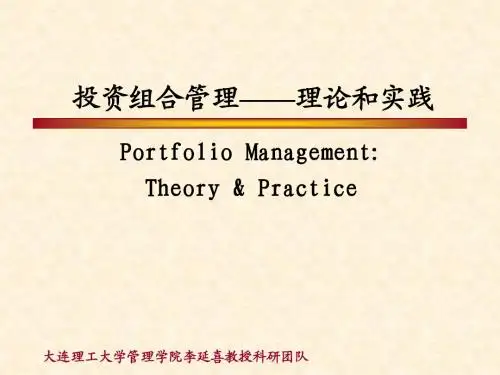

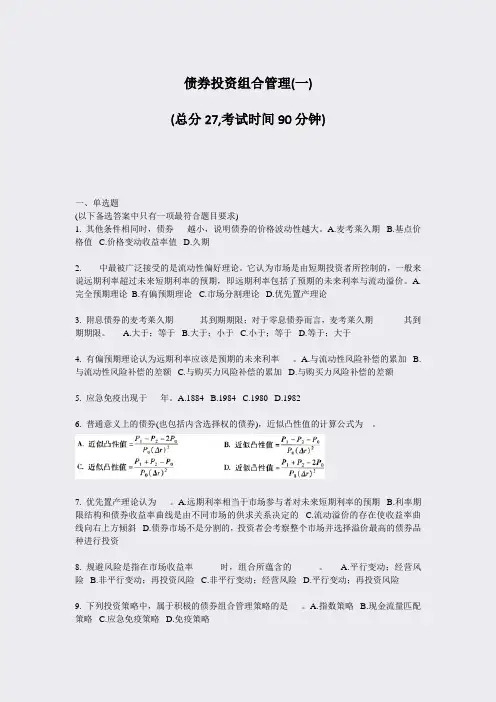
债券投资组合管理(一)(总分27,考试时间90分钟)一、单选题(以下备选答案中只有一项最符合题目要求)1. 其他条件相同时,债券越小,说明债券的价格波动性越大。
A.麦考莱久期 B.基点价格值 C.价格变动收益率值 D.久期2. 中最被广泛接受的是流动性偏好理论。
它认为市场是由短期投资者所控制的,一般来说远期利率超过未来短期利率的预期,即远期利率包括了预期的未来利率与流动溢价。
A.完全预期理论B.有偏预期理论 C.市场分割理论 D.优先置产理论3. 附息债券的麦考莱久期______其到期期限;对于零息债券而言,麦考莱久期______其到期期限。
A.大于;等于 B.大于;小于 C.小于;等于 D.等于;大于4. 有偏预期理论认为远期利率应该是预期的未来利率。
A.与流动性风险补偿的累加 B.与流动性风险补偿的差额 C.与购买力风险补偿的累加 D.与购买力风险补偿的差额5. 应急免疫出现于年。
A.1884 B.1984 C.1980 D.19826. 普通意义上的债券(也包括内含选择权的债券),近似凸性值的计算公式为。
7. 优先置产理论认为。
A.远期利率相当于市场参与者对未来短期利率的预期 B.利率期限结构和债券收益率曲线是由不同市场的供求关系决定的 C.流动溢价的存在使收益率曲线向右上方倾斜 D.债券市场不是分割的,投资者会考察整个市场并选择溢价最高的债券品种进行投资8. 规避风险是指在市场收益率______时,组合所蕴含的______。
A.平行变动;经营风险 B.非平行变动;再投资风险 C.非平行变动;经营风险 D.平行变动;再投资风险9. 下列投资策略中,属于积极的债券组合管理策略的是。
A.指数策略 B.现金流量匹配策略 C.应急免疫策略 D.免疫策略10. 高收益债券又可以称为。
A.垃圾债券 B.完美债券 C.无风险债券 D.贴现债券11. 其他条件相同时,债券价格收益率值变小,说明债券的价格波动性。
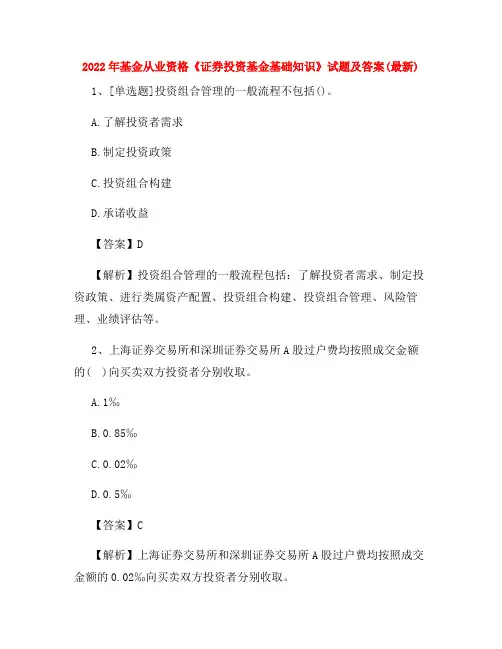
2022年基金从业资格《证券投资基金基础知识》试题及答案(最新)1、[单选题]投资组合管理的一般流程不包括()。
A.了解投资者需求B.制定投资政策C.投资组合构建D.承诺收益【答案】D【解析】投资组合管理的一般流程包括:了解投资者需求、制定投资政策、进行类属资产配置、投资组合构建、投资组合管理、风险管理、业绩评估等。
2、上海证券交易所和深圳证券交易所A股过户费均按照成交金额的( )向买卖双方投资者分别收取。
A.1‰B.0.85‰C.0.02‰D.0.5‰【答案】C【解析】上海证券交易所和深圳证券交易所A股过户费均按照成交金额的0.02‰向买卖双方投资者分别收取。
3、零息债券偿还期限多为( )。
A.1年或1年以下B.1年或1年以上C.5年或5年以上D.5年或5年以下【答案】A【解析】零息债券多为1年或1年以下。
4、某养老基金资产组合的年初值为50万美元,前6个月的收益率为15%,下半年发起人又投入50万美元,年底资产总值为118万美元,则其时间加权收益率为( )。
A.9.77%B.15.00%C.18.00%D.26.23%【答案】D【解析】前6个月的收益率为15%;后6个月的收益率=[118-50-50×(1+15%)]/[50+50×(1+15%)]=9.77%;时间加权收益率=(1+15%)×(1+9.77%)-1=26.23%。
5、[单选题]下列属于零售房地产的是( )。
A.购物中心B.写字楼C.酒店D.养老院【答案】A【解析】商业房地产投资以出租而赚取收益为目的,其投资对象主要包括写字楼、零售房地产等设施。
零售房地产是指如购物中心、商业购物中心和其他用于零售目的而建设的建筑物。
所有者将房地产出租给零售商进行经营。
6、如果证券价格中已经反映了影响价格的全部信息,那么该证券市场被称为( )。
A.半强有效市场B.弱有效市场C.无效市场D.强有效市场【答案】D【解析】强有效市场是指与证券有关的所有信息,包括公开发布的信息和未公开发布的内部信息,都已经充分、及时地反映到了证券价格中。
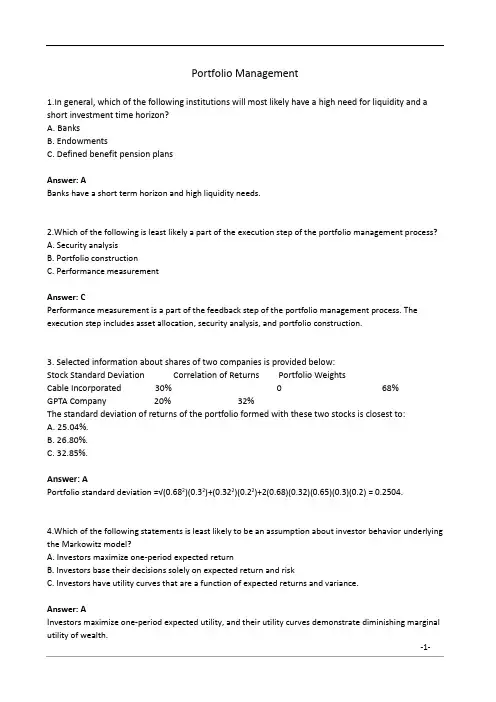
Portfolio Management1.In general, which of the following institutions will most likely have a high need for liquidity and a short investment time horizon?A. BanksB. EndowmentsC. Defined benefit pension plansAnswer: ABanks have a short term horizon and high liquidity needs.2.Which of the following is least likely a part of the execution step of the portfolio management process?A. Security analysisB. Portfolio constructionC. Performance measurementAnswer: CPerformance measurement is a part of the feedback step of the portfolio management process. The execution step includes asset allocation, security analysis, and portfolio construction.3. Selected information about shares of two companies is provided below:Stock Standard Deviation Correlation of Returns Portfolio WeightsCable Incorporated 30% 0 68%GPTA Company 20% 32%The standard deviation of returns of the portfolio formed with these two stocks is closest to:A. 25.04%.B. 26.80%.C. 32.85%.Answer: APortfolio standard deviation =√(0.682)(0.32)+(0.322)(0.22)+2(0.68)(0.32)(0.65)(0.3)(0.2) = 0.2504.4.Which of the following statements is least likely to be an assumption about investor behavior underlying the Markowitz model?A. Investors maximize one-period expected returnB. Investors base their decisions solely on expected return and riskC. Investors have utility curves that are a function of expected returns and variance.Answer: AInvestors maximize one-period expected utility, and their utility curves demonstrate diminishing marginal utility of wealth.-1-5.Relative to an investor with a steeper indifference curve, the optimal portfolio for an investor with a flatter indifference curve will most likely have:A. a lower level of risk and returnB. a higher level of risk and returnC. the same level of risk and returnAnswer = BBecause a less risk-averse investor’s highest utility, given the low slope of his indifference curve, is likely to touch the capital allocation line at a point which would represent a portfolio with higher risk and more expected return.6. Which of the following statements is least accurate? An investor may construct a portfolio located on the capital market line (CML) by:A. investing a portion of his capital in the risk-free asset and the balance in a fully diversified portfolio of all equitiesB. investing a portion of his capital in the risk-free asset and the balance in a fully diversified portfolio of all risky assetsC. borrowing capital at the risk-free rate and investing all his capital plus all borrowed capital in a fully diversified portfolio of all risky assetsAnswer: AThis statement is incorrect. Portfolios located on the CML may be constructed by: 1) investing a portion of an investor’s capital in the risk-free asset and the balance in the market portfolio which consists of all risky assets, or 2) borrowing capital at the risk-free rate and investing all of an investor’s capital plus all borrowed capital in the market portfolio.7.A completely diversified portfolio will most likely result in the elimination of:A. systematic varianceB. unsystematic varianceC. both systematic and unsystematic varianceAnswer: BA completely diversified portfolio, such as the market portfolio, will eliminate all unsystematic risk. Systematic risk cannot be diversified away.8.The slope of the security market line (SML) represents the portion of an asset’s expected return attributable to:A. total risk.B. market risk.C. diversifiable risk.-2-Answer: BThe slope of the SML is the market risk premium, E(Rm) – Rf. It represents the return of the market less the return of a risk-free asset. Thus, the slope represents the portion of expected return that reflects compensation for market or systematic risk.9. The following table shows data for the stock of JKU and a market-index.Expected return of JKU: 15%Expected return of market index:12%Risk free rate: 5%Standard deviation of JKU returns: 20%Standard deviation of market index returns: 15%Correlation of JKU and market index returns: 0.75Based on the capital asset pricing model (CAPM), JKU is most likely:A. overvalued.B. undervalued.C. fairly valued.Answer = BβJKU= ρJKU,M×σJKU/ σM = 0.75×0.2/0.15 = 1.0 E(R JKU) = RFR + βJKU x (R M– RFR) = 0.05 +1 x (0.12 – 0.05) = 0.12 The required rate of return of JKU is 12% and the expected return of JKU is 15% therefore JKU is undervalued relative to the Security Market Line (SML). The risk-return relationship lies above the SML.10. Which of the following factors is least likely to impact an individual’s ability to take risk?A. Time horizonB. Personality typeC. Expected incomeAnswer = BAn individual’s ability to take risk is impacted by such factors as time horizon and expected income. Personality type is most likely to impact an individual’s willingness to take risk.-3-。
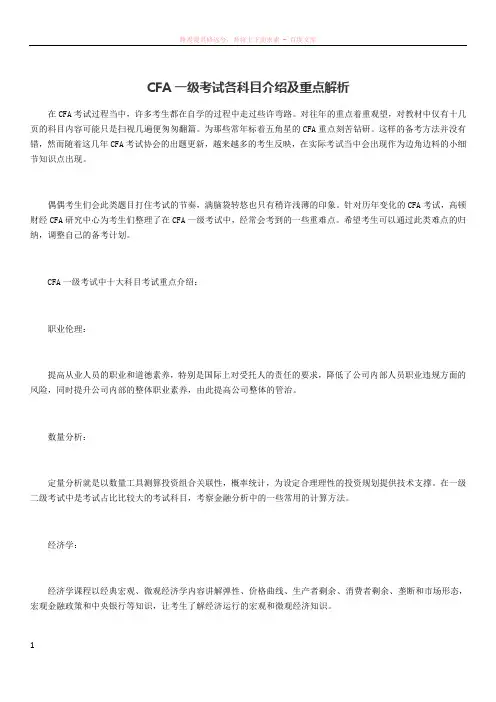
CFA一级考试各科目介绍及重点解析在CFA考试过程当中,许多考生都在自学的过程中走过些许弯路。
对往年的重点着重观望,对教材中仅有十几页的科目内容可能只是扫视几遍便匆匆翻篇。
为那些常年标着五角星的CFA重点刻苦钻研。
这样的备考方法并没有错,然而随着这几年CFA考试协会的出题更新,越来越多的考生反映,在实际考试当中会出现作为边角边料的小细节知识点出现。
偶偶考生们会此类题目打住考试的节奏,满脑袋转悠也只有稍许浅薄的印象。
针对历年变化的CFA考试,高顿财经CFA研究中心为考生们整理了在CFA一级考试中,经常会考到的一些重难点。
希望考生可以通过此类难点的归纳,调整自己的备考计划。
CFA一级考试中十大科目考试重点介绍:职业伦理:提高从业人员的职业和道德素养,特别是国际上对受托人的责任的要求,降低了公司内部人员职业违规方面的风险,同时提升公司内部的整体职业素养,由此提高公司整体的管治。
数量分析:定量分析就是以数量工具测算投资组合关联性,概率统计,为设定合理理性的投资规划提供技术支撑。
在一级二级考试中是考试占比比较大的考试科目,考察金融分析中的一些常用的计算方法。
经济学:经济学课程以经典宏观、微观经济学内容讲解弹性、价格曲线、生产者剩余、消费者剩余、垄断和市场形态,宏观金融政策和中央银行等知识,让考生了解经济运行的宏观和微观经济知识。
财务报表分析:财务报表是一级二级的考试重点,内容涉及三大会计报表,现金流量测控,养老会计、管理会计、税收规避FACC 等会计术语,考试难度不大,并且现在的考核方式更加灵活。
一级二级中财务报表是重点科目,占比考试20%左右的权重,权重较大。
公司理财:公司理财详细的介绍了资本的成本,使公司规划出最合适的资本结构,来获得资本的最优收益。
在制定资本预算时,可做出正确的现金流量估计和风险分析,从而作出正确的决定。
在决定股利政策时,充分了解其中的资讯和意义。
深入地了解如何实现公司融资结构与投资结构的最优化。
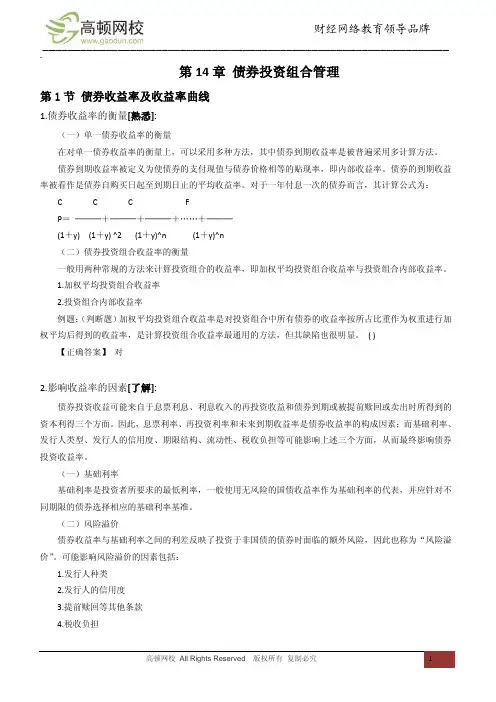
第14章债券投资组合管理第1节债券收益率及收益率曲线1.债券收益率的衡量[熟悉]:(一)单一债券收益率的衡量在对单一债券收益率的衡量上,可以采用多种方法,其中债券到期收益率是被普遍采用多计算方法。
债券到期收益率被定义为使债券的支付现值与债券价格相等的贴现率,即内部收益率。
债券的到期收益率被看作是债券自购买日起至到期日止的平均收益率。
对于一年付息一次的债券而言,其计算公式为:C C C FP=───+───+───+……+───(1+y) (1+y) ^2 (1+y)^n (1+y)^n(二)债券投资组合收益率的衡量一般用两种常规的方法来计算投资组合的收益率,即加权平均投资组合收益率与投资组合内部收益率。
1.加权平均投资组合收益率2.投资组合内部收益率例题:(判断题)加权平均投资组合收益率是对投资组合中所有债券的收益率按所占比重作为权重进行加权平均后得到的收益率,是计算投资组合收益率最通用的方法,但其缺陷也很明显。
( ) 【正确答案】对2.影响收益率的因素[了解]:债券投资收益可能来自于息票利息、利息收入的再投资收益和债券到期或被提前赎回或卖出时所得到的资本利得三个方面。
因此,息票利率、再投资利率和未来到期收益率是债券收益率的构成因素;而基础利率、发行人类型、发行人的信用度、期限结构、流动性、税收负担等可能影响上述三个方面,从而最终影响债券投资收益率。
(一)基础利率基础利率是投资者所要求的最低利率,一般使用无风险的国债收益率作为基础利率的代表,并应针对不同期限的债券选择相应的基础利率基准。
(二)风险溢价债券收益率与基础利率之间的利差反映了投资于非国债的债券时面临的额外风险,因此也称为“风险溢价”。
可能影响风险溢价的因素包括:1.发行人种类2.发行人的信用度3.提前赎回等其他条款4.税收负担5.债券的预期流动性6.到期期限例题:风险溢价的影响因素不包括( )。
A.无风险的国债收益率B.发行人种类C.发行人的信用度D.提前赎回条款答案:A3.收益率曲线[熟悉]:将不同期限债券的到期收益率按偿还期限连接成一条曲线,即是债券收益率曲线,它反映了债券偿还期限与收益的关系。
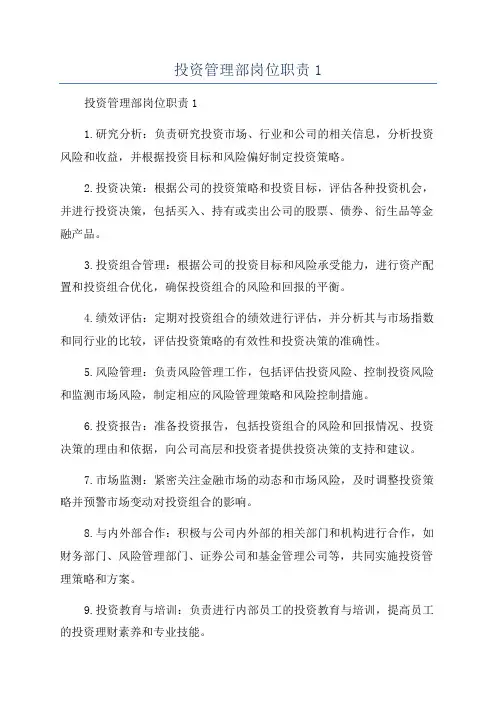
投资管理部岗位职责1投资管理部岗位职责11.研究分析:负责研究投资市场、行业和公司的相关信息,分析投资风险和收益,并根据投资目标和风险偏好制定投资策略。
2.投资决策:根据公司的投资策略和投资目标,评估各种投资机会,并进行投资决策,包括买入、持有或卖出公司的股票、债券、衍生品等金融产品。
3.投资组合管理:根据公司的投资目标和风险承受能力,进行资产配置和投资组合优化,确保投资组合的风险和回报的平衡。
4.绩效评估:定期对投资组合的绩效进行评估,并分析其与市场指数和同行业的比较,评估投资策略的有效性和投资决策的准确性。
5.风险管理:负责风险管理工作,包括评估投资风险、控制投资风险和监测市场风险,制定相应的风险管理策略和风险控制措施。
6.投资报告:准备投资报告,包括投资组合的风险和回报情况、投资决策的理由和依据,向公司高层和投资者提供投资决策的支持和建议。
7.市场监测:紧密关注金融市场的动态和市场风险,及时调整投资策略并预警市场变动对投资组合的影响。
8.与内外部合作:积极与公司内外部的相关部门和机构进行合作,如财务部门、风险管理部门、证券公司和基金管理公司等,共同实施投资管理策略和方案。
9.投资教育与培训:负责进行内部员工的投资教育与培训,提高员工的投资理财素养和专业技能。
10.进一步提升投资管理能力:积极学习各种金融工具和投资策略的相关知识,不断提升投资管理能力和专业素养。
总结起来,投资管理部门是负责公司的投资决策和资产管理工作的部门,岗位职责涉及投资研究、投资决策、投资组合管理、绩效评估、风险管理、投资报告、市场监测、与内外部合作、投资教育与培训等工作内容。
投资管理部需要具备丰富的投资知识和专业技能,并具备良好的分析能力、决策能力和沟通能力,能够为公司提供有效的投资决策支持,实现资产的保值增值。
2024年3月第27卷第5期中国管理信息化China Management InformationizationMar.,2024Vol.27,No.5[10]张志成,张艳.中心极限定理在实际中的应用[J].河南工学院学报,2020,28(4):28-30.[11]李广平.基于价值观的人力资源管理:GE人力资源管理体系剖析[D].郑州:郑州大学,2004.基于强化学习PPO算法的上市公司投资组合管理代一方(南京财经大学 经济学院,南京 210000)[摘 要]传统的投资组合管理方法往往依赖于经验规则或数学模型,难以充分利用市场信息和动态调整投资策略。
为了解决这一问题,文章提出一种基于强化学习PPO(Proximal Policy Optimization)算法的新方法。
使用上市公司的历史数据进行训练和测试,与传统投资策略和其他强化学习算法进行比较,实验结果表明,基于强化学习PPO算法的投资组合管理方法在投资回报率和风险控制方面取得了显著的改进。
[关键词]强化学习;PPO算法;投资组合管理;上市公司doi:10.3969/j.issn.1673-0194.2024.05.042[中图分类号]F830.9 [文献标识码]A [文章编号]1673-0194(2024)05-0140-041 文献综述上市公司投资组合管理是金融领域的重要问题之一,它涉及如何有效地分配投资资金以取得最大化回报并控制风险。
随着金融市场越来越复杂,传统的投资组合管理方法难以适应快速变化的市场环境。
因此,寻求新的投资策略和方法变得至关重要。
强化学习作为一种基于智能体与环境交互学习的方法,在解决复杂决策问题方面展现出巨大潜力。
近年来,强化学习在金融领域的应用引起了广泛关注,并取得了令人瞩目的成果。
齐岳等(2018)利用深度强化学习中确定性策略梯度DDPG算法构建投资组合管理模型,通过控制每个股票的投资比例,降低整体的风险,此外,还采用Dropout的方法,有效地避免出现过拟合的情况[1]。
Portfolio Management1.In general, which of the following institutions will most likely have a high need for liquidity and a short investment time horizon?A. BanksB. EndowmentsC. Defined benefit pension plansAnswer: ABanks have a short term horizon and high liquidity needs.2.Which of the following is least likely a part of the execution step of the portfolio management process?A. Security analysisB. Portfolio constructionC. Performance measurementAnswer: CPerformance measurement is a part of the feedback step of the portfolio management process. The execution step includes asset allocation, security analysis, and portfolio construction.3. Selected information about shares of two companies is provided below:Stock Standard Deviation Correlation of Returns Portfolio WeightsCable Incorporated 30% 0 68%GPTA Company 20% 32%The standard deviation of returns of the portfolio formed with these two stocks is closest to:A. 25.04%.B. 26.80%.C. 32.85%.Answer: APortfolio standard deviation =√(0.682)(0.32)+(0.322)(0.22)+2(0.68)(0.32)(0.65)(0.3)(0.2) = 0.2504.4.Which of the following statements is least likely to be an assumption about investor behavior underlying the Markowitz model?A. Investors maximize one-period expected returnB. Investors base their decisions solely on expected return and riskC. Investors have utility curves that are a function of expected returns and variance.Answer: AInvestors maximize one-period expected utility, and their utility curves demonstrate diminishing marginal utility of wealth.-1-5.Relative to an investor with a steeper indifference curve, the optimal portfolio for an investor with a flatter indifference curve will most likely have:A. a lower level of risk and returnB. a higher level of risk and returnC. the same level of risk and returnAnswer = BBecause a less risk-averse investor’s highest utility, given the low slope of his indifference curve, is likely to touch the capital allocation line at a point which would represent a portfolio with higher risk and more expected return.6. Which of the following statements is least accurate? An investor may construct a portfolio located on the capital market line (CML) by:A. investing a portion of his capital in the risk-free asset and the balance in a fully diversified portfolio of all equitiesB. investing a portion of his capital in the risk-free asset and the balance in a fully diversified portfolio of all risky assetsC. borrowing capital at the risk-free rate and investing all his capital plus all borrowed capital in a fully diversified portfolio of all risky assetsAnswer: AThis statement is incorrect. Portfolios located on the CML may be constructed by: 1) investing a portion of an investor’s capital in the risk-free asset and the balance in the market portfolio which consists of all risky assets, or 2) borrowing capital at the risk-free rate and investing all of an investor’s capital plus all borrowed capital in the market portfolio.7.A completely diversified portfolio will most likely result in the elimination of:A. systematic varianceB. unsystematic varianceC. both systematic and unsystematic varianceAnswer: BA completely diversified portfolio, such as the market portfolio, will eliminate all unsystematic risk. Systematic risk cannot be diversified away.8.The slope of the security market line (SML) represents the portion of an asset’s expected return attributable to:A. total risk.B. market risk.C. diversifiable risk.-2-Answer: BThe slope of the SML is the market risk premium, E(Rm) – Rf. It represents the return of the market less the return of a risk-free asset. Thus, the slope represents the portion of expected return that reflects compensation for market or systematic risk.9. The following table shows data for the stock of JKU and a market-index.Expected return of JKU: 15%Expected return of market index:12%Risk free rate: 5%Standard deviation of JKU returns: 20%Standard deviation of market index returns: 15%Correlation of JKU and market index returns: 0.75Based on the capital asset pricing model (CAPM), JKU is most likely:A. overvalued.B. undervalued.C. fairly valued.Answer = BβJKU= ρJKU,M×σJKU/ σM = 0.75×0.2/0.15 = 1.0 E(R JKU) = RFR + βJKU x (R M– RFR) = 0.05 +1 x (0.12 – 0.05) = 0.12 The required rate of return of JKU is 12% and the expected return of JKU is 15% therefore JKU is undervalued relative to the Security Market Line (SML). The risk-return relationship lies above the SML.10. Which of the following factors is least likely to impact an individual’s ability to take risk?A. Time horizonB. Personality typeC. Expected incomeAnswer = BAn individual’s ability to take risk is impacted by such factors as time horizon and expected income. Personality type is most likely to impact an individual’s willingness to take risk.-3-。